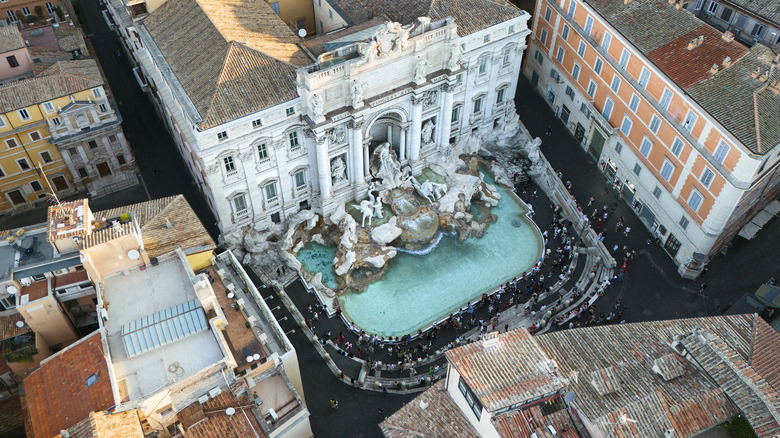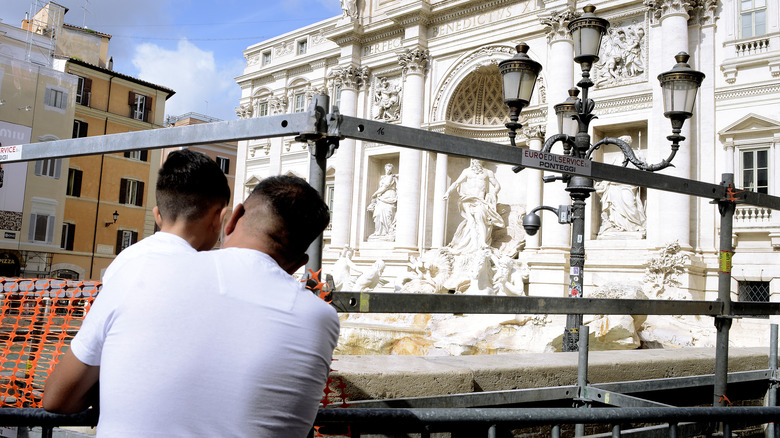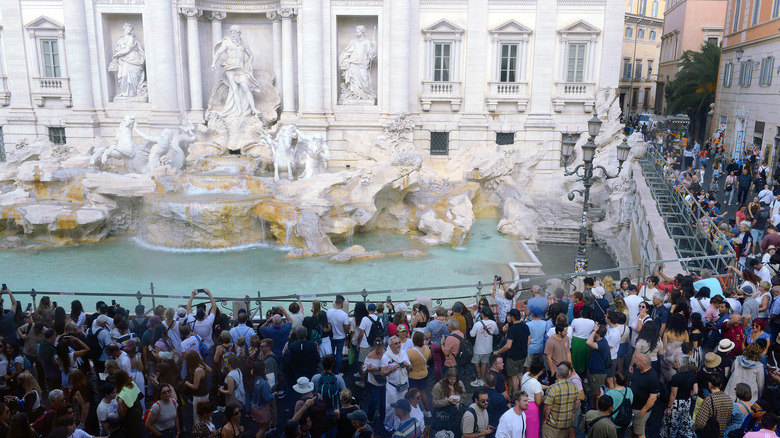You Might Miss Out On One Of Rome's Most Iconic Tourist Attractions
The Trevi Fountain sees tens of thousands of visitors every day, many of whom are drawn to the site for the chance to toss a coin into its basin — an act believed to grant the thrower their wish to revisit the Italian capital someday. Visitors to Rome during the remainder of 2024 will need to do more than bet on a return trip in order experience the Trevi Fountain in its full splendor.
Roman officials emptied the fountain in October to clean and restore the landmark ahead of the Vatican's Jubilee, a Catholic Holy Year when about 35 million people are expected to make a pilgrimage to the Eternal City. An exact date for completion of the maintenance project hasn't been provided, but Roman officials said it could be done by the end of the year. Until then, tourists will have to settle for a different experience — one that's already proven to be unpopular.
The city erected a barrier and set up a makeshift pool encased in plywood at the front of the fountain, where tourists can continue to toss their coins. (Here's what happens to all those coins.) Soon after it went up, the pool began receiving harsh reviews on social media. On X, people described it as "ridiculous," "ugly," and @mamboitaliano_ even said it was "the saddest thing I've seen in Italy."
A different perspective of the Trevi
A silver lining of visiting the Baroque fountain sometime during the next few months is that visitors will soon be able to view it from a unique position. City workers were building a temporary walkway at the beginning of November that will carry tourists over the basin. In a news release, Roman officials dubbed it as a way to "admire the monument from an unusual and close-up perspective." Visitors will be able to get a closer look at the statue of Oceanus, the Titan god of freshwater, which is the fountain's focal point.
The walkway serves another purpose: to track the number of tourists visiting the Trevi Fountain. Only a limited number of visitors will be allowed on the walkway at any given time, and the city plans to collect data about how many people show up and what times are the busiest. Officials said the data was expected to help solve the problem of overcrowding. Anyone who's visited the iconic fountain — especially during peak travel times — has likely experienced large groups of people pushing through Piazza di Trevi for their opportunity to snap a photo and toss a coin. It gets so busy that some people consider the Trevi Fountain one of the main tourist traps to skip in Italy.
In an attempt to manage congestion in the piazza, Rome's top tourism official, Alessandro Onorato, proposed a plan earlier this year to establish a reservation system and charge visitors 2 euros, or about $2.20, to approach the fountain's edge. He hoped the idea might be put in place in time for the city's Jubilee year, though it remains unsure whether the plan will be approved.
In need of repair
City leaders insist the fountain was due for repairs. The most recent restoration project at the Trevi Fountain was completed a decade ago, in 2014 and 2015. Workers are cleaning the stone surfaces and grouting some areas, tasks made more complex and time-intensive because of the different materials used in the fountain, including marble, stucco, limestone, and metals. The Trevi isn't the only fountain in Rome to get a renovation. The work on the landmark is part of a larger project that includes four other fountains: the Quirinale Fountain, the Barcaccia Fountain, the Turtle Fountain, and the Tiara Fountain. It's coming at a cost of about 1.19 million euros, or 1.3 million dollars.
Though the maintenance project is disappointing to some visitors, Onorato believes it's "an important and valuable intervention" for the site's future, he said in a news release. The Trevi Fountain is expected to remain a bucket-list destination, with visitors drawn to the site because of its prominence in pop culture. (It appears in movies spanning the decades, from 1953s Roman Holiday to the Lizzie McGuire Movie in 2003.) As well as its significance as a symbol of the engineering acumen of ancient Romans. The fountain is the endpoint of the Aqua Virgo aqueduct, constructed in 19 B.C., and was used as a water source for the city's early residents.
If you visit the fountain after it's reopened, be sure to follow the rules, which include one of the things tourists should never do when visiting Italy: touching the Trevi Fountain's water. Bathing, taking coins, or trying to scoop out water are all considered illegal acts.


